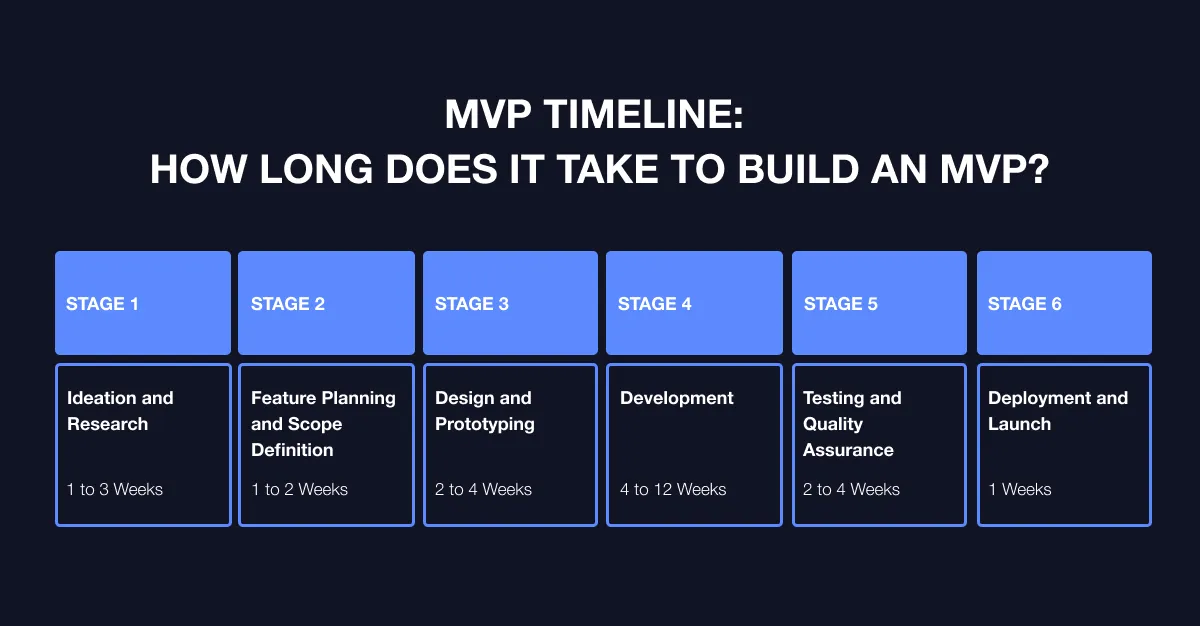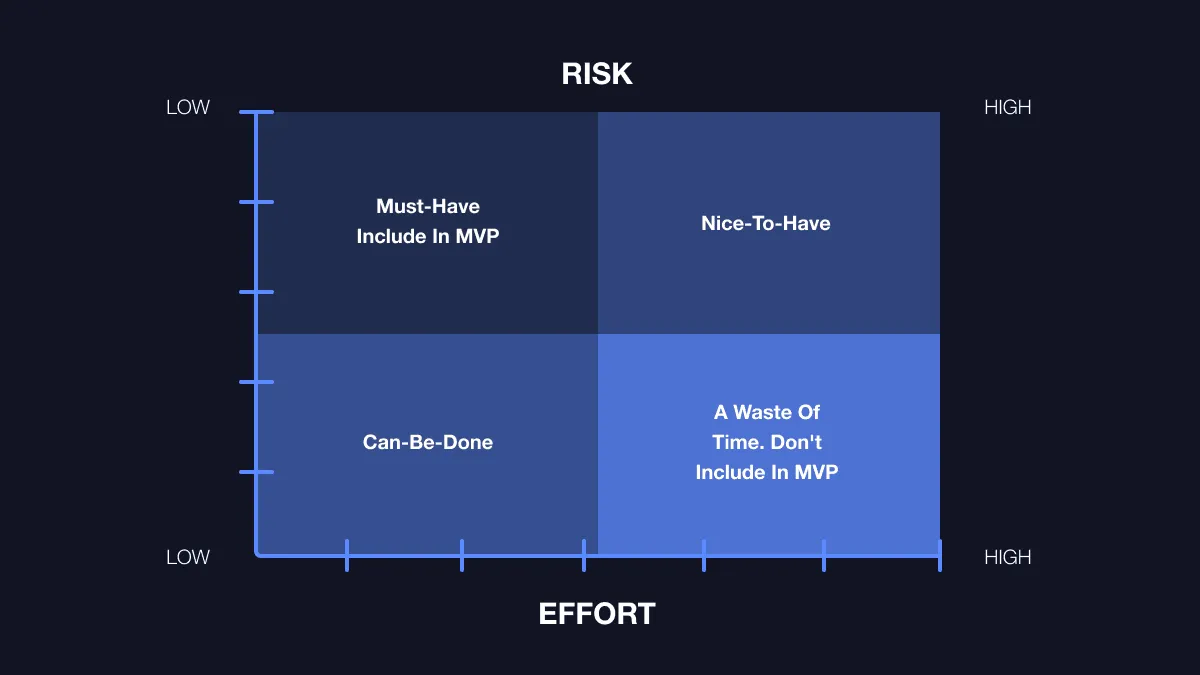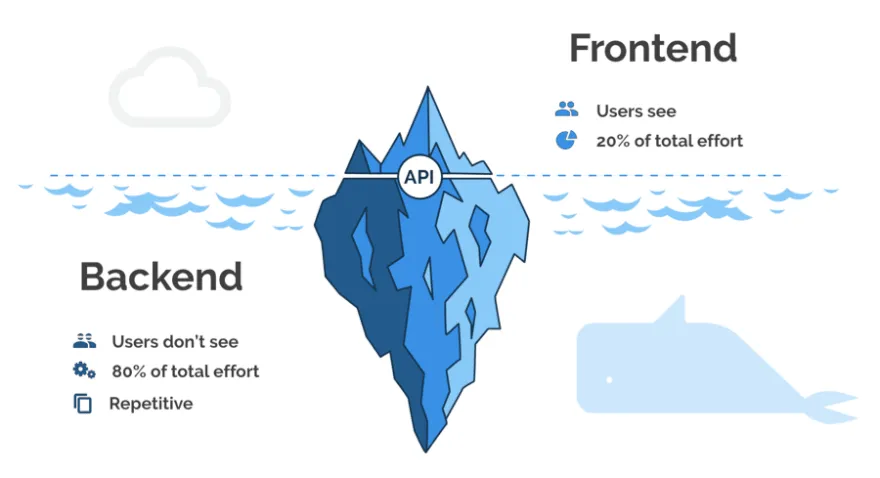EXPLORE
Got a Question? Connect with our experts.
Talk to an Expert
Got a Question? Connect with our experts.
Talk to an Expert
Creating a Minimum Viable Product (MVP) is a crucial step for any startup or business looking to test an idea or concept with real users.
While the goal of an MVP is to develop a product with only the features needed to validate the business idea, the time it takes to build one can vary significantly depending on several factors.
Phases of Building an MVP
Building an MVP typically follows a structured process that involves multiple stages. We will go through each phase and explain the key activities involved and why each phase takes the amount of time it does.
Phase 1: Ideation and Research (1-3 weeks)

Source: Atlassian
In this phase, you usually define the problem and identify the solution.
To be precise, identify the core problem your product is solving and the simplest solution possible to address that problem.
You will also research your target audience and competitors.

This helps validate if there is a market for your idea.
Finally, you will ask the question, “What will the MVP accomplish?” It will help in defining the key metrics and success factors.
The ideation phase requires collaboration between founders, stakeholders, and possibly consultants to ensure that the product aligns with user needs.
Phase 2: Feature Planning and Scope Definition (1-2 weeks)
This phase is important to determine which features are necessary for the MVP.
These should be the minimum set of functionalities that solve the problem.
The Pareto principle:
“20% of the causes produce 80% of the consequences, and the remaining 80% of the causes produce only 20% of the consequences.”
Applying the Pareto principle to the MVP feature list would mean that 20% of the features will bring 80% of the benefits to your customers.
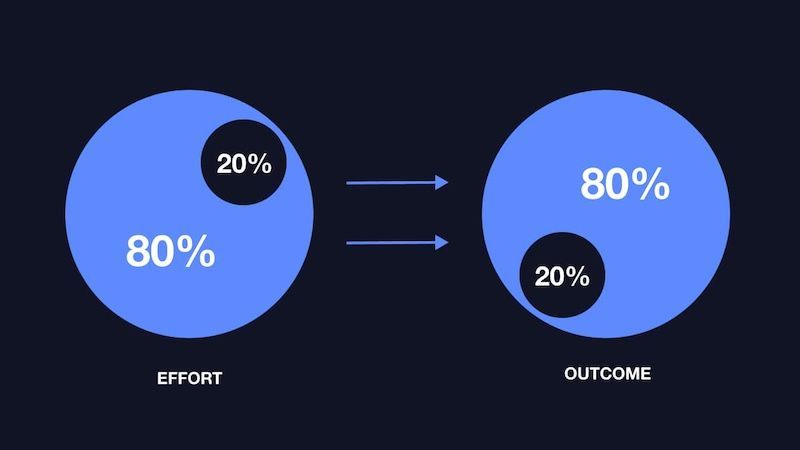
MVP = Essential + Simple
There are multiple techniques on how to determine the essential features of the MVP.
What will help is to rank the features based on their impact and necessity. Avoid adding anything non-essential at this stage.
And then, plan the development process, milestones, and deadlines for each feature. Meaning a clear product roadmap.
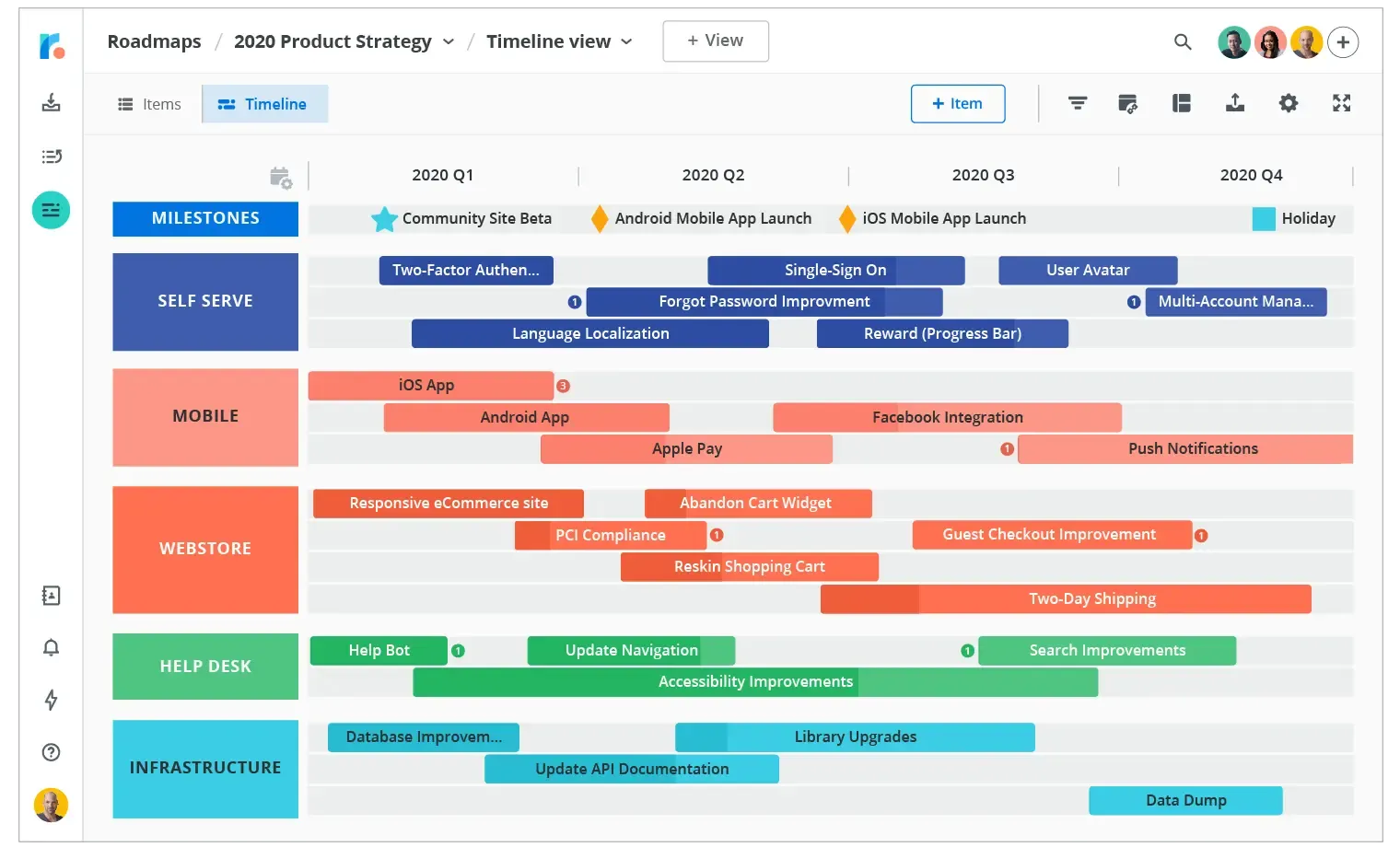
source: Roadmunk
This phase usually takes between 1-2 weeks.
It may take longer if there are debates on what features should be included, or if the team has trouble narrowing down to only the most critical features.
This stage is crucial for managing scope and staying focused on the product’s key functionality.
Phase 3: Design and Prototyping (2-4 weeks)
Now it's time to turn your vision into a visual prototype.

Source: Justinmind
Wireframing
The first step in the actual design process is creating wireframes.
Wireframes are an initial sketch of your MVP’s UI.
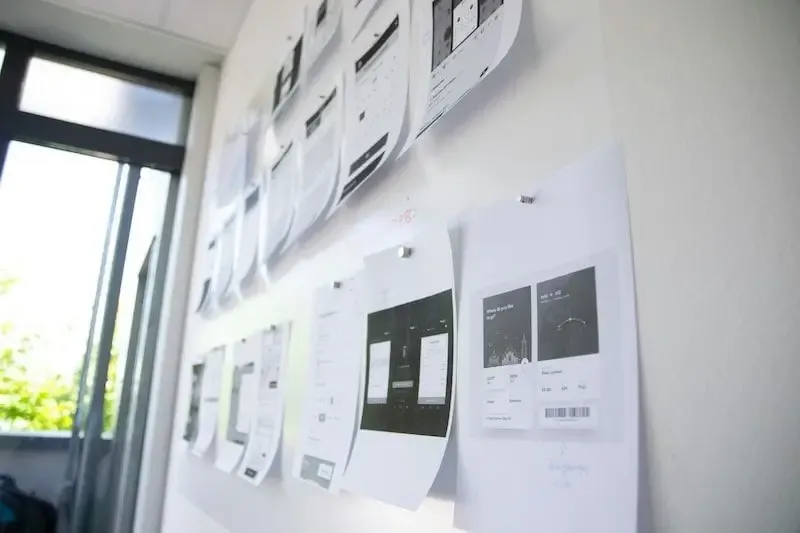
Wireframes can be super simple, they can be done on paper with a pen.
The goal of this step is to get an idea of where are you going to place elements of your MVP.
Wireframes will help you lay out information architecture, user flow, and functionality.
Mockups and prototyping
Once you’ve wireframed your MVP, you should make mockups.
Mockups are a basic static version of your app.
Don't go into too much detail and spend hours designing every little detail since there might be some changes later in the process.
Mockups are all about creating a visual representation of your MVP in order to gather the initial feedback.
Hi-Fi prototyping
After testing your mockups, it's time to refine the design and create a high-fidelity prototype.
Hi-Fi prototypes are highly interactive and visually polished, closely resembling the final product.
They include detailed visuals, animations, and near-full functionality, making them perfect for usability testing and stakeholder presentations.
For a simple MVP, this phase could take as little as 2 weeks. However, if the design is more complex or custom, it could extend to 4 weeks.
The timeline also depends on whether you have a UI/UX designer in-house or need to hire someone externally.
Phase 4: Development (4-12 weeks)
source: plopdo.com
The development phase will have 3 important areas to consider:
- Backend development
- Frontend development
- Third-party Integrations
In the backend, we will set up the server, database, and APIs.
The user-facing art of the MVP will be the front-end development, which ensures alignment with the design that was decided.
Then the final stage of combining or integrating the backend and frontend, ensuring that the product works seamlessly.
This is the most variable phase.
For a basic MVP with minimal features, development might take around 4-6 weeks.
For more complex applications (e.g., apps with authentication, payment integration, or large-scale features), this phase could extend to 12 weeks.
The complexity of your features and the technologies used will heavily influence this timeline.
Phase 5: Testing and Quality Assurance (2-4 weeks)
Your MVP is developed. But it can’t be sent out to the world without testing it first.
First impressions always last.
So making sure your product is free of bugs and performs the best is absolutely crucial.
In this phase, we will identify and fix any issues that arise during development. Also making sure that the MVP works well under normal usage conditions.
It's highly recommended to test your product with a small group of real users before the full launch. This helps gather valuable feedback on usability and functionality, allowing you to refine and improve the product.
There is an old MVP development joke, that goes:
A QA engeneer walks into a bar. Orders a beer. Orders 0 beers. Orders 9999999 beers. Orders a lizard. Orders a -1 beers. Orders an asdffgh. Everything works as intented.
Then a first real users walks in and asks where is the bathrom. The bar bursts into flames.
The takeaway: You can't predict user behavior, so the sooner you involve real users, the better. It will allow you to tailor your product to fit their needs.
Testing is an iterative process and is crucial for ensuring that the product is functional and stable.
A basic MVP might require just 2 weeks, but if your product involves complex integrations or functionalities, this phase might take 4 weeks.
Phase 6: Deployment and Launch (1 week)

source: avenga.com
Now that you have reached the final stage. Your MVP is developed, tested, and ready to launch.
It's time to set up your hosting environment and deploy the MVP. But, it is necessary to track real-time data and identify any issues post-launch.
Deployment is usually quicker than other phases, typically taking 1 week.
However, if your MVP requires setting up infrastructure, cloud services, or more advanced deployment setups, it could take longer.
How Timelines Can Vary Based on Different Scenarios
We now have a rough idea of the time estimates for each phase of building an MVP, and we have also discussed how timelines can vary based on the complexity of these phases. But what exactly causes these complexities
While an MVP is typically a simple, easy-to-use product, your vision for the product or the solution you are creating may require more advanced features. When this happens, the timeline can shift significantly.
In this section, we will explore a few such scenarios to give you a clearer idea of what these complexities might look like and how they impact the overall timeline.
Scenario 1: Website vs Mobile App Development or Both
You might decide a website or web page is your MVP.
A website typically is faster to build than a mobile app. A completely functional website should take around 8-12 weeks.
Mobile apps require platform-specific development (iOS, Android), increasing the complexity. A simple mobile app could take 12-16 weeks.
Mobile apps often require more effort in terms of development, testing, and deployment (especially with Apple’s and Google’s approval processes).
Websites, on the other hand, are typically easier to launch and maintain.
If you decide that your solution requires both the website and a mobile app, then you can add both (and can also work simultaneously if you have the resources).
| Platform | Timeline |
|---|---|
| Website | 8-12 Weeks |
| Mobile App | 12-16 Weeks |
Scenario 2: Payment Integrations, User Profiles, CMS...
What is the most important thing your product should do?
It could be anything from enabling user profiles, making payments, and sending notifications, to as complex as providing a marketplace, or all of the features.
The more features or functionality you require in your MVP, the more time it will take. A few examples are:
If you want users to pay directly from your website or app, adding payment functionality (e.g., PayPal, Stripe) can add 2-4 weeks to the timeline. It also involves security considerations and integration testing.
If your MVP requires user registration, profiles, and user-specific data, this adds 2-3 weeks for development.
Implementing a simple CMS can take an additional 2-3 weeks, especially if you need custom features like dynamic content management.
| Features | Timeline |
|---|---|
| Payment Integration | Additional 2-4 Weeks |
| User Profiles | Additional 2-3 Weeks |
| CMS | Additional 2-3 Weeks |
| Document Management System | Additional 2-3 Weeks |
| AI Implementation | Additional 2-3 Weeks |
Scenario 3: Design Complexity
If your design is basic with standard elements and limited branding, this may take 2-3 weeks.
If you need a customized but not overly complex design, expect it to take 4-6 weeks.
If the design is custom, intricate, and highly polished, this could extend design and prototyping to 8 weeks or more.
| Design | Timeline |
|---|---|
| Basic Design and Limited Branding | 2-3 Weeks |
| Customized Design but Not Overly Complex | 4-6 Weeks |
| Custom, Intricate, Highly Polished Design | 8+ Weeks |
Scenario 4: Data Collection
Suppose you want to collect user data with your MVP that will require a data collection infrastructure.
Setting up proper backends, analytics tools, and data storage systems may extend the timeline by a week.
Additionally, depending on how much data you need to collect, this could delay your timeline.
For instance, setting up for A/B testing or gathering feedback might extend the timeline by a few weeks.
| Data Collection | Timeline |
|---|---|
| Analytics, Data Storage Systems | Additional 1 Week |
| A/B Testing Data, Gathering Customer Feedback | Additional 2 Weeks |
Scenario 5: Security Features
Security is required for any product.
If you are planning to collect user data, handle payments through your MVP, and more, then you will need tightened security, like, encryption, two-factor authentication, or secure data handling.
This will add an extra 2-3 weeks to your timeline.
| Security Feature | Timeline |
|---|---|
| Basic Security like SSL | Does not affect timeline |
| Advanced Security like Encryption, 2FA etc | Additional 2-3 Weeks |
Scenario 6: In-App Purchases, E-Commerce, Subscription...
If you are looking to make money directly from your MVP, then you should have features like ad inventory or a subscription model, etc.
Setting up a subscription model, including recurring billing and related functionalities may add 4-6 weeks.
If your idea is to add in-app purchases then integrating APIs into mobile apps or a web-based purchasing system could add 3-4 weeks.
A basic e-commerce platform (product listings, cart, checkout) typically takes 3-4 weeks.
| Monetization Model | Timeline |
|---|---|
| Subscription Model | Additional 4-6 Weeks |
| In-App Purchases | Additional 3-4 Weeks |
| E-Commerce | Additional 3-4 Weeks |
How Does Cost Affect Timeline?
A key consideration when determining the timeline for your MVP is your budget. The larger your budget, the more resources you can allocate to speeding up the development process.
A bigger budget allows you to hire more developers, designers, and QA testers, which can significantly speed up the project.
However, for an MVP, having a large team may not always be necessary, as the goal is to validate the idea with a minimal feature set.
If your budget is limited, the team may be smaller, and the process may take longer as a result.
In some cases, working with fewer resources means a slower pace, but this can be a strategic choice when testing a concept with minimal risk.
Conclusion
Building an MVP is an essential step in validating your business idea, but the timeline can vary significantly depending on the complexity of the product and the features you want to include.
We hope our article provided you with a better understanding of how much time different phases require, and upon adding more complexity, how the timeline varies. We also wanted you to understand what exactly these complexities are, and hence we provided a few scenarios which you can keep in mind while building your MVP.


Wondering how long your MVP will take to build?
Use our free MVP time and cost calculator to get a tailor-made estimate.
Estimate MVP Development Costs & Time


